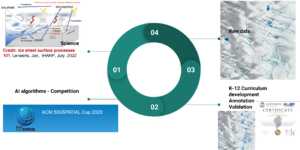Annotating Supraglacial Lakes
The tracking of lakes through a melt season, when they fill, how much they fill, and (most importantly) when they drain, throughout a year, and tracking those trends across years, will help us solidify our understanding of the way water on the ice sheet is behaving in a rapidly changing climate over Greenland. Due to the lack of annotated data iHARP (led by Dr. Mike MacFerrin) along with Earthrise Genome partners (Dr. Edward Boyda and Ms.Kim Young) worked with high schoolers across two semesters. A curriculum unit was developed in partnership on polar ice sheet lakes, followed by data annotation for the supraglacial lakes. The annotated data was then used to organize the ACM SIG Spatial cup to create new AI algorithms for supraglacial lake detection.
K-12 Partnership
In partnership with Earth Genome, across two semesters over 1000 students participated (650 students from 9 schools by April 2023; 405 students from 8 schools by August 2023) delineating 23,909 meltwater lakes, water-filled cracks, and moulins on the ice sheet near Ilulissat. They also collected 16,820 point and polygon features delineating lake boundaries or lake basins which emptied or refroze during the period from early June to late August.
The data are presented as a web map over the SkySat and Sentinel-2 imagery from which the students collected the data. The SkySat imagery was collected on August 30 and September 29, 2019, and the Sentinel-2 data spanned four different dates throughout the 2019 Greenland melt season
ACM SIG Spatial Competition 2023
The student lake data was used for the 2023 SIGSPATIAL machine learning competition in Fall 2023, to collect an ensemble of algorithms for automated detection of meltwater lakes on the Greenland ice sheet.
iHARP Talk Tuesday showcase for the project: Active learning on the ice sheet: Classroom mapping of meltwater lakes and cracks in satellite imagery by Edward Boyda and Kim Young along with experiences from students and teachers.
Participating Schools
Team members
Earth Genome Partners:
Ms. Kim Young
Dr. Edward Boyda
iHARP:
Dr. Mike MacFerrin (iHARP Team Lead), CU Boulder
Dr. Aneesh Subramanian, CU Boulder
Dr. Mohamed Mokbel, University of Minnesota
Dr. Vandana Janeja, University of Maryland, Baltimore County
